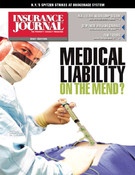Maryland Sen. Alex Mooney (R-Frederick) fought a ticket for running a red light last year despite film showing his car blowing through an intersection. A judge accepted proof that a car thief, not Mooney, was behind the wheel.
But Mooney is still miffed, and not merely at being wrongly accused of a traffic violation. His objections run deeper and are one sign of a hostile response that can be found in some of the 18 states and 107 cities that have installed cameras at intersections to catch red-light runners.
Despite studies that show photo enforcement dramatically reduces accidents, resentment at traffic cameras playing “gotcha” shows why laws using photography to catch violators might not be a slam-dunk for states considering ways to improve roadway safety. Still, advocates insist the hassles are worth it to prevent traffic accidents.
Mooney has unsuccessfully sought to repeal Maryland’s red-light camera law, objecting to its assumption that car owners are guilty until proven innocent.
“At some point, enough people will have gotten these tickets, and there will be a backlash. It’s revenue for local governments. Let’s just be honest about it,” he said.
Mooney and other opponents complain that red-light camera laws are un-American because they presume guilt and invade privacy. Opponents also point to studies in Charlotte, N.C., and San Diego that suggest rear-end collisions increase when drivers slam on the brakes after seeing the cameras.
Critics condemn the cameras as a sneaky revenue generator for local governments and for camera companies that also get a cut from the motorists’ fines in many jurisdictions. Electronic Data Systems Corp., of Plano, Texas, and Affiliated Computer Systems Inc. of Dallas (which acquired Lockheed Martin IMS) are among camera vendors.
“With anyone who is proposing the use of the camera, look at how they will benefit from it,” said Eric Skrum, spokesman for the National Motorists Association, an advocacy group. Skrum’s group has issued a $10,000 challenge to encourage communities to try engineering changes, such as lengthening a yellow light or making a stoplight more visible, instead of cameras.
If re-engineering doesn’t reduce red-light violations by 50 percent, his group promises to give communities $10,000. In two years, no community considering red-light cameras has accepted the offer, Skrum said.
In Baltimore, the cameras are on trial: A $10-million class-action suit charges that the traffic lights with cameras had unusually short yellow lights, less than three seconds. In response, Maryland lawmakers passed a law this year that requires yellow lights to last 3.5 seconds if there is a camera at the intersection. The lawsuit continues.
The New York Assembly this summer capped New York City’s red-light cameras at 50 despite Mayor Michael Bloomberg’s request to double the number of city intersections under surveillance. More than 300,000 red-light violations were issued in New York last year, and traffic deaths have dropped from 701 in 1990 to 344 last year, The New York Daily News reported.
Some drivers are starting to use reflective license plate covers and sprays to thwart the cameras. Colorado passed a law this year making it illegal to obscure a license plate so it can’t be photographed. But another new Colorado law seeks to give drivers fair warning-and a chance to slow down-by requiring signs announcing the presence of a camera to be posted a reasonable distance from an intersection.
Another help to drivers is a Web site called PhotoEnforced.com, which identifies camera-patrolled intersections and applicable fines all over the country.
Was this article valuable?
Here are more articles you may enjoy.


 FM Global Rebrands As FM
FM Global Rebrands As FM  What Happened to Reinsurance ‘Class of 2023’? Hard Market Defies Age-Old Patterns.
What Happened to Reinsurance ‘Class of 2023’? Hard Market Defies Age-Old Patterns.  Viewpoint: Deepfake Fraud Is On the Rise. Here’s How Insurers Can Respond
Viewpoint: Deepfake Fraud Is On the Rise. Here’s How Insurers Can Respond  Travelers Reverses Q2 Income Loss, Narrows Underwriting Loss
Travelers Reverses Q2 Income Loss, Narrows Underwriting Loss 


